astrophysics
Latest

Strange interstellar object 'Oumuamua is tiny and very reflective
After no small amount of mystery, we're starting to understand more about 'Oumuamua, the first known interstellar object to visit the Solar System. A newly published study indicates that the object can't be that large, for one thing. As the Spitzer Space Telescope's infrared detection couldn't catch the cigar-shaped entity, that makes it relatively small. It's likely less than half a mile (2,600 feet) at its longest. It also can't have a diameter larger than 1,440 feet, and that figure could be as small as 320 feet.
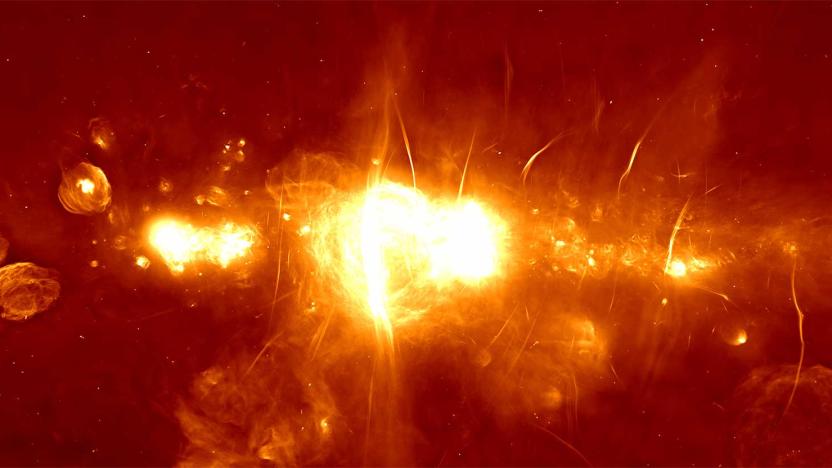
Ultra-sensitive radio telescope debuts in South Africa
Another piece of the Square Kilometer Array's puzzle just fell into place. South Africa has officially switched on MeerKAT, billed as the most sensitive radio telescope of its type on the planet. Some parts of the array have been gathering data, but it's now nearly ready to use interferometry from all 64 dishes to map the normally invisible portions of space in exceptionally high detail. It should be completely ready for scientific experiments in about two months, according to Nature. However, you won't have to wait that long to see fresh results -- you're looking at some above.
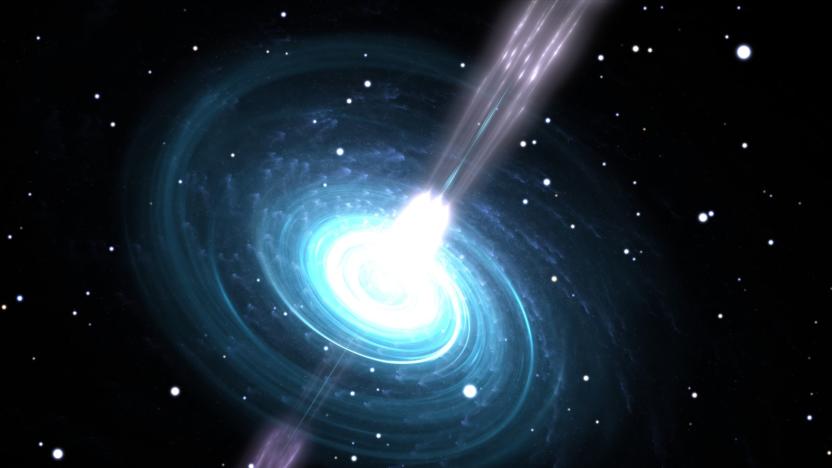
Radio telescopes show theory of gravity holds in extreme situations
Radio telescopes have been crucial to some significant discoveries regarding the nature of the universe. Now, though, they're verifying the basic rules of the cosmos. An international group of astronomers has shown that Einstein's theory of gravity holds up even in more extreme situations. The team spent six years using a trio of radio telescopes (Arecibo, Green Bank and Westerbork Synthesis) to track an unusual three-star system with a pulsar bracketed by two white dwarfs -- a textbook example of extreme gravity in action. How that pulsar moved would determine whether or not Einstein's concept passed muster.

Scientists validate theory of relativity on galactic level
Einstein's theory of general relativity is rather important when it's crucial to the modern understandings of the universe and technology like satellites. But does it hold up with something as vast as a galaxy? Thanks to researchers, we know the answer is "yes." They've conducted a test that used two comparatively distant galaxies, one in front of the other, to show that relativity checks out.
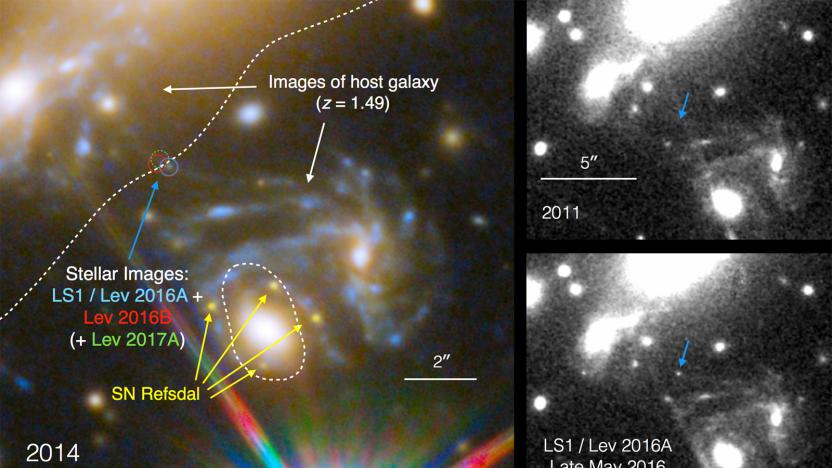
Hubble space telescope spots the farthest known star
Astronomers have spotted numerous extremely distant galaxies, but spotting individual stars is understandably much more difficult unless they go supernova. Sometimes, though, cosmic alignment works in their favor. Researchers using Hubble space telescope data have spotted Icarus (aka MACS J1149+2223 Lensed Star 1), a blue supergiant whose light was emitted when it was 9 billion light years away from Earth -- over 100 times farther than the previous record-setter. They captured the star thanks to a rare, ideal gravitational lensing effect where the star's light was magnified not only by the gravity of an in-between galaxy cluster 5 billion light years from Earth, but by a star inside that cluster. All told, the lensing magnified Icarus 2,000 times.

Video offers peek at ultra-wide Large Synoptic Survey Telescope
The Large Synoptic Survey Telescope has been a long time in the making when work on its mirrors started in 2007. It's finally coming together, though. The LSST team has released a brief clip showing progress on the Chilean facility as of the end of 2017. Not surprisingly, it's huge -- that giant 3.2-gigapixel camera (potentially the largest in the world) and ultra-wide optics (3.5 degrees in diameter) take up a lot of space by themselves, let alone the rest of the complex.

Researchers observe the first known interstellar comet
To date, every comet humanity has seen inside the Solar System has come from the Solar System, whether it's the Kuiper Belt or the billions of comets believed to make up the Oort Cloud. Now, however, it looks like astronomers might have found a comet of interstellar origin. They've used Hawaii's Pan-STARRS 1 telescope to track C/2017 U1, an object with a very eccentric, hyperbolic orbit (that is, moving quickly enough to escape gravitational pull) that wasn't connected to the Sun. The trajectory suggests that it's a comet which escaped from a nearby star, rather than something knocked out a familiar path and drawn in by the Sun's gravity.

Stephen Hawking makes his doctoral thesis available online
Ever wondered how Stephen Hawking saw the universe as a doctoral candidate, when his theories about black holes were just coming into fruition? You don't have to hear about it second-hand -- you can now go straight to the source. The legendary cosmologist has published his 1966 doctoral thesis online for anyone to read, making it available to the public for the first time. Hawking is posting his work in hopes that it'll spark interests in both space itself and sharing research. "I hope to inspire people around the world to look up at the stars and not down at their feet," he said.

Astronomers just measured a whole lot more than gravitational waves
A couple of weeks ago, the LIGO (Laser Interferometer Gravitational-Wave Observatory) and Virgo teams announced the detection of another set of gravitational waves -- the fourth since LIGO's first detection in September of 2015. The observations of these ripples in spacetime are extraordinary in and of themselves, no matter how many times we record them. However, while the first three sets of gravitational waves recorded were by the two LIGO observatories, the fourth was also detected by a newly established third -- Virgo -- located in Italy. And having three detectors allows researchers to triangulate the source of those waves with extraordinary precision.
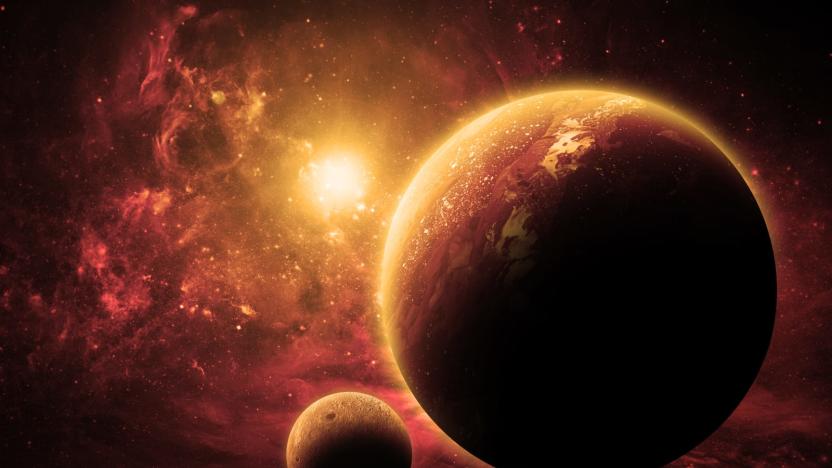
Scientists may have found a Neptune-sized alien moon
Astronomers have found an abundance of exoplanets, but no exomoons. Despite ongoing efforts, the tiny celestial bodies have just been too elusive to detect using modern technology. However, researchers might have just hit paydirt. They've used Kepler Space Telescope data to discover signs of what looks like a Neptune-sized moon orbiting a planet in the Kepler-1625 system, 4,000 light years away from Earth. They were tipped off to the companion when they noticed dips in brightness (indicative of an object transiting in front of a star) around a planet during three of its transits. It's a very promising piece of evidence, but we wouldn't bet money just yet -- there's some homework left to do before the discovery is validated.

Stars can turn into black holes without a supernova
As a rule, astronomers believe that stars have to explode in a supernova before they collapse into black holes. That violent death is always the cue, right? Not necessarily. Researchers have spotted a massive star 22 million light years away, N6946-BH1, that appears to have skipped the supernova step entirely -- it brightened slightly and just disappeared. Checks have ruled out a dimmed star or dust. And this probably isn't a one-off incident, either. Ohio State University's Christopher Kochanek tells NASA that 10 to 30 percent of massive stars might die in failed supernovae.

Construction starts on the world's largest optical telescope
After several years of planning and no shortage of financial anxiety, construction has officially started on the Extremely Large Telescope. Contractors are now building the main structure and dome of the Chile-based observer ahead of its initial service in 2024. That's a long time to wait, but this is no mean feat. With a 43-yard aperture, this promises to be the world's largest optical telescope for sometime, even compared to future or in-limbo projects like the Thirty Meter Telescope. Those gigantic dimensions will help it capture far more light, giving astronomers the chance to spot particularly distant galaxies, find small planets and capture more details of larger planets.
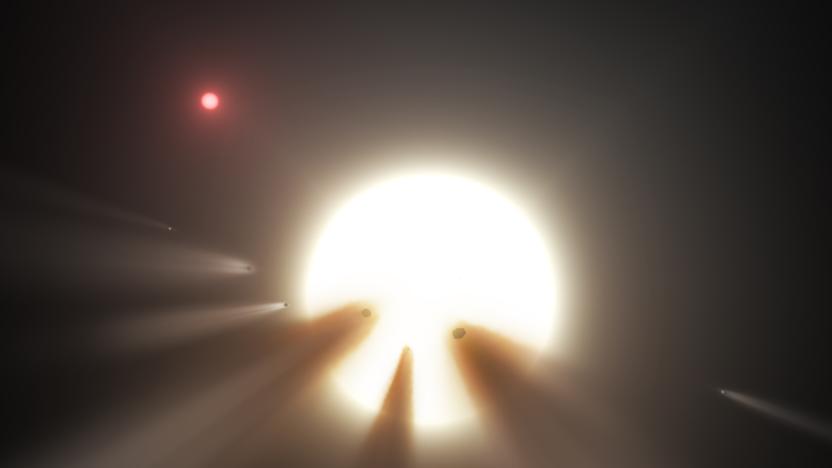
Live look at the 'alien megastructure' star may solve mysteries
Astronomers may have ruled out an alien megastructure as the likely cause behind KIC 8462852's strange dimming, but it's still mysterious -- and that's partly due to the lack of live data (as live as you can get for a star 1,277 light years away, at least). How do you understand what's going on when you have to rely solely on historical info that doesn't even account for the star's spectrum? Thankfully, researchers are getting that big chance: they've caught the star in mid-dimming, and they have numerous telescopes trained on it. If they can record the spectrum before and after the oddball behavior, they may have a better idea of the root cause.

Most habitable planets may be completely covered in water
When you imagine what a rocky, habitable planet looks like, it's easy to picture an alternate Earth where land and oceans exist in an ideal balance. Unfortunately, that's not necessarily how it will pan out in real life... in fact, you might be surprised if there's land at all. University of Barcelona researcher Fergus Simpson has published a study suggesting that most planets with any significant amount of water are likely to be completely (or almost completely) submerged in it. He ran computer simulations accounting for numerous factors in a planet (such as the deep water cycle and erosion), and most with substantial water levels had an above-water land mass of less than 10 percent -- well below Earth's 29 percent.
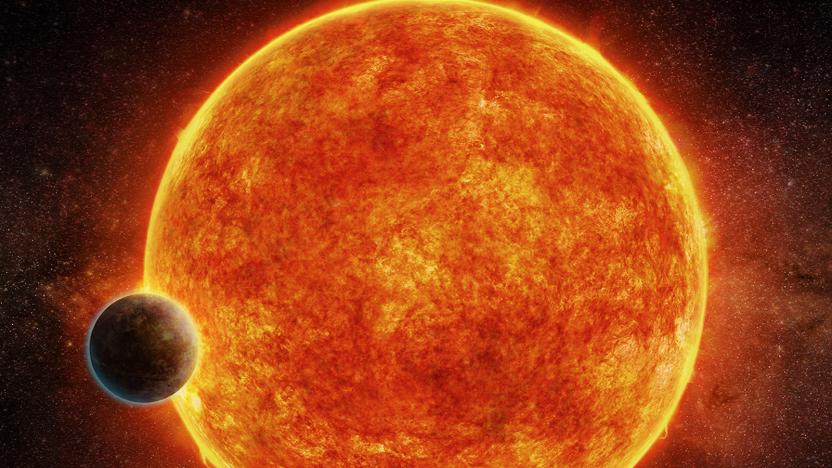
Nearby 'super-Earth' may be our best shot yet at finding alien life
Scientists are finding potentially life-bearing planets at a surprisingly high rate, but the latest may be more tantalizing than most. A research team has discovered LHS 1140b, a temperate rocky exoplanet orbiting the habitable zone of a tiny star 40 light years away. While it's not the first such planet found relatively nearby, it's an ideal candidate for study -- since it transits in front of its host, astronomers could look for water and oxygen in the planet's atmosphere by watching how it filters starlight. The star itself also doesn't emit much high-energy radiation, so there's a greater chance of life than you might see around stars like TRAPPIST-1.

One of Jupiter's asteroid 'moons' is orbiting backwards
As a rule, you can safely assume that moons and asteroids will all orbit in the same direction. If they didn't, interactions with their host would likely send them flying off course. However, it's now clear that there are exceptions to this rule: researchers have discovered that an asteroid is crossing Jupiter in the opposite direction of all planets in the Solar System. These backwards-orbiting rocks are rare anywhere in the system (they represent just 0.01 percent of known asteroids), but this is the very first time one has been caught doing so in tandem with a planet. How is it sticking around, then?

NASA is crowdsourcing the search for exoplanets
To those of you who dream of going to space: Sorry, but that may never happen. However, NASA is once again counting on the public for help understanding what's beyond our world. All we have to do is look at some photos online. Today marks the launch of Backyard Worlds: Planet 9, a project that relies on everyday people to help scientists identify objects near our solar system. These celestial bodies appear to move across the sky, but computers have a hard time finding things like brown dwarfs and planets in the noisy images. This means manually searching the photos is the most effective method to get the job done.

Dwarf star's atmosphere holds the ingredients for life
One of the biggest questions in the search for life in the universe is a simple one: how common are the ingredients needed to make life-giving planets? They might be more widespread than you think. Astronomers have discovered that a white dwarf star in the Boötes constellation, WD 1425+540, has an atmosphere chock full of the carbon, hydrogen, nitrogen and oxygen needed for life as we know it. The researchers believe that the star picked up these elements after ripping up a small rock-and-water planet when it veered too close. The finding suggests that rocky planets like Earth don't need to be born with life-giving material -- even a "dry" example orbiting close to its star might pick up those substances through one of these stellar impacts.

Gamma ray telescope spots ancient, intense black holes
NASA's Fermi gamma ray telescope has been working overtime, it seems. Scientists using the instrument have spotted extreme astronomical phenomenon both at the far edge of the universe and close to home. They've detected the farthest known blazars, or galaxies whose central black holes are so massive (over 1 million times the Sun's mass) that they emit extremely intense light in every spectrum, including gamma rays. The oldest example existed just 1.4 billion years after the Big Bang -- ancient compared to the previous record-setter, which was visible "just" 2.1 billion years after the birth of the universe.
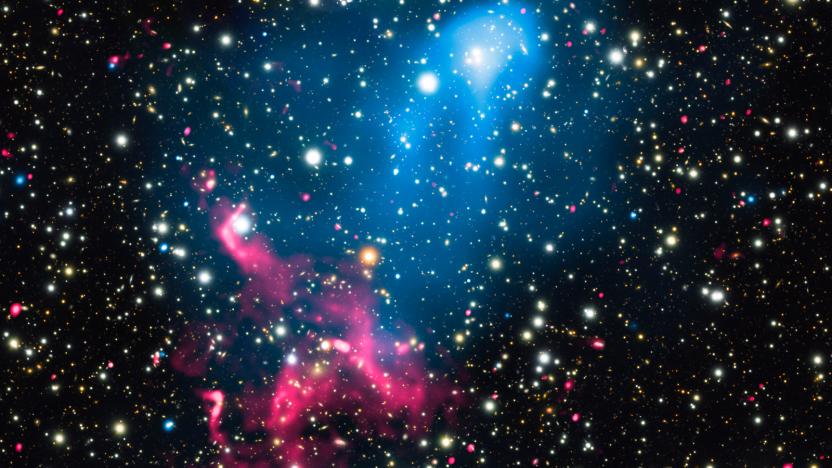
Scientists discover a cosmic-scale particle accelerator
Suddenly, even the Large Hadron Collider seems downright quaint. Researchers have found a combination of cosmic phenomena that's creating the universe's largest known particle accelerator. At least one supermassive black hole in a galaxy cluster has created a electromagnetic tunnel that's accelerating gas to high speeds, only for the gas to travel even faster as it interacts with shock waves from another cluster colliding with the first. The result is particles traveling at a significant portion of the speed of light -- no mean feat for anything that isn't, well, light.


